Winter Food Dynamics and Waterfowl Use in
Managed Moist-soil Wetlands in the Mississippi
Alluvial Valley
Principal Investigator
Dr. Rick Kaminski
Mississippi State University Department of Wildlife and Fisheries
Graduate Research Assistants
Heath M. Hagy
Mississippi State University Department of Wildlife and Fisheries
Moist-soil wetlands are important habitats for migrating and wintering waterbirds and have been increasingly incorporated into waterfowl management complexes in the Mississippi Alluvial Valley (MAV) and elsewhere in the United States. As expanding human development, potential climate change, and increasing agricultural intensification threaten to reduce wetland areas for wildlife, managers should improve quality of wetlands and ensure adequate foraging and other habitats exist to meet goals of the North American Waterfowl Management Plan and other conservation initiatives.
Managing moist-soil wetlands for early succession vegetation (e.g., annual grasses, sedges, and herbaceous plants) can increase natural plant and invertebrate foods. Farmers and wildlife managers in the MAV often use disking and mowing to maintain early succession plant communities and, in fall, create openings in dense emergent vegetation which may otherwise deter late fall-early winter waterfowl use. Fall manipulations of moist-soil vegetation (e.g., mowing, disking, or rolling) and sequential flooding may increase winter waterfowl use and maintain early succession plant communities the following year in moist-soil wetlands.
We evaluated waterfowl and waterbird responses to fall manipulations of mowing, light disking, and no manipulation (control) of moist-soil vegetation in natural wetlands in the MAV in fall and winter 2006 - 2009. Throughout each winter, we sampled seed, tuber, and aquatic macroinvertebrate resources and conducted waterfowl observations in each treatment of moist-soil vegetation.
We found that dabbling ducks used mowed plots most followed by disked and non-treated areas (control) and that mowed and control plots had the greatest seed, tuber, and invertebrate abundance in late fall and lowest decomposition during winter. Preliminary analyses suggest that winter waterfowl abundance and availability of moist-soil seeds, tubers, and invertebrates may be greatest in response to partial fall mowing of moist-soil vegetation. We encourage habitat managers to mow strips or irregular openings in tall, dense stands of moist-soil vegetation and then flood to create a 'hemi-marsh' for wintering waterfowl (i.e., half standing vegetation and half open water in a highly interspersed arrangement).
Additionally, we noticed that moist-soil foods remained greater at the end of winter than what had been reported in other regions and wetlands previously. Greater levels of food resources in moist-soil wetlands at the end of winter may indicate that waterfowl stop using or give-up foraging on these foods at levels greater than originally thought. Previous studies have estimated "giving-up" density (GUD) - a lower threshold of food availability at which waterfowl may cease foraging or abandon habitats because nutrient acquisition does not meet physiological needs given costs of additional foraging - for rice grain in flooded rice fields at 50 kg/ha in the MAV. However, no previously published study has reported a GUD for seeds, tubers, and aquatic macroinvertebrates in moist-soil habitats. Estimates of GUD in moist-soil wetlands will enable wildlife managers to determine waterfowl carrying capacity accurately and enhance cost-efficiency of habitat conservation planning and implementation.
We evaluated waterfowl use and food resource dynamics in managed moist-soil wetlands in winters 2006 - 2009 in the MAV to estimate food density at which waterfowl abandoned habitats, stopped foraging, or greatly reduced depletion of food resources per unit effort (% ducks foraging/survey). We found that combined late-winter moist-soil seed, tuber, and invertebrate abundances in mowed, disked and non-manipulated moist-soil wetlands were ~50% lower than in late fall, but remained ~7 times greater than the GUD estimate for harvested rice fields. Additionally, seeds, tubers, and invertebrates did not decline markedly from December - February each year, in spite of continued waterfowl foraging in these wetlands during winter. Therefore, we designed additional field experiments to estimate GUD for seeds in moist-soil wetlands.
We conducted a series of experiments to estimate GUD in February - March 2008 and December 2008 - March 2009. We added Japanese millet (Echinochloa esculenta; hereafter millet), as a surrogate moist-soil seed, to moist-soil wetlands in 3 densities (50 kg/ha [GUD in harvested rice fields], 250 kg/ha [a preliminary GUD estimate for moist-soil wetlands], and 550 kg/ha [late fall MAV moist-soil seed and tuber abundance]). We collected waterfowl abundance and foraging data 4 - 5 times per week and soil cores 2 weeks after addition and then monthly until early March 2008 - 2009.
During these experiments, waterfowl abandoned experimental wetlands or no longer depleted food resources when 200 - 300 kg/ha of moist-soil seeds and millet remained. Natural seeds were depleted by ~40% while millet declined by ~85%. We estimated decomposition of millet to be 34% in experimental wetlands during the same period. GUD was variable among sites, but did not vary among the three treatment abundances within any particular site and remained ~ 4 - 6 times greater than the density experimentally determined for waste rice and 2 - 3 times greater than the GUD of moist-soil seeds in other regions. Furthermore, GUD was reached in all wetlands 2 - 6 weeks following millet addition.
Increased GUD for moist-soil seeds in the MAV might indicate the need for more active management of moist-soil wetlands, increased abundance of moist-soil and other foraging habitats, leaving some portion of crops not harvested, or a combination of these alternatives to produce greater food availability for waterfowl.
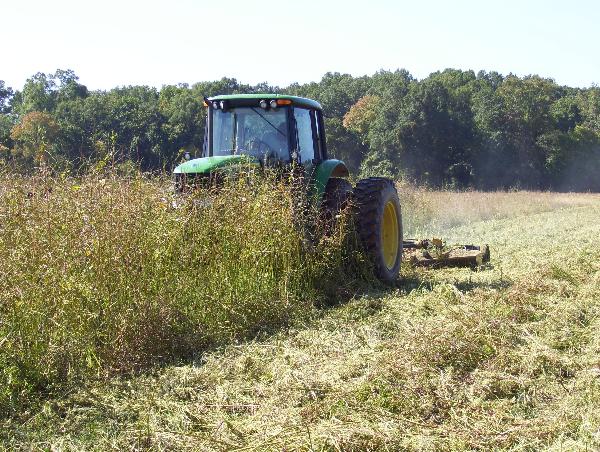
Wildlife managers often mow moist-soil plants after they mature to knock the seeds on the ground, making them more accessible to waterfowl during winter.
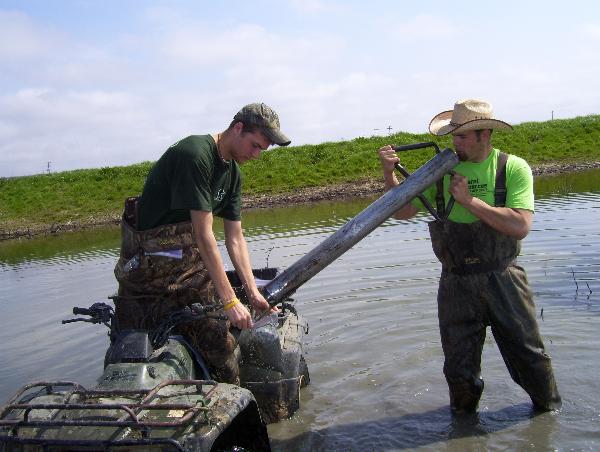
Graduate student Heath Hagy (right) samples a soil core in a flooded field to measure moist-soil seed availability before fall migration begins.
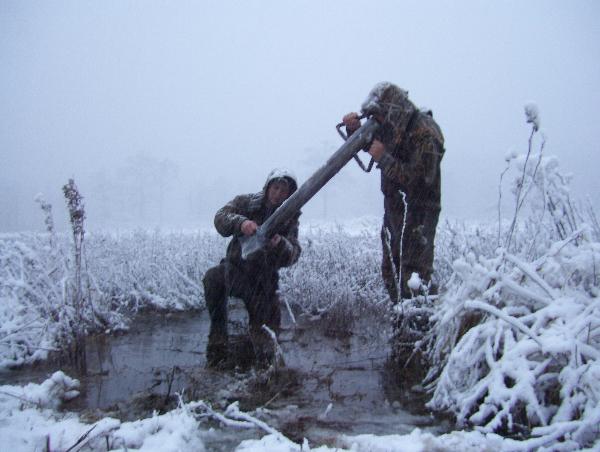
Sampling moist-soil seeds during winter also provides information about moist-soil seed availability later in the year.
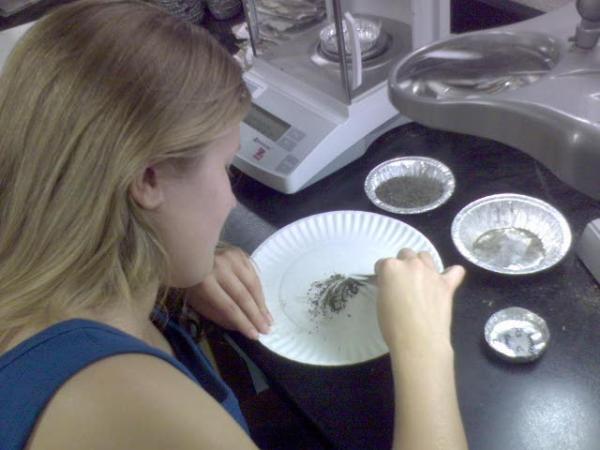
Once back in the laboratory, seeds are separated from the soil cores and counted to determine total production.
Funding for this project was provided by:
 |
 |
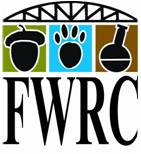 |
 |









